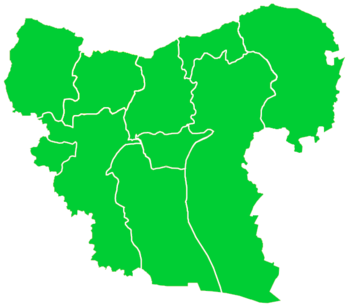Tell Rifaat
| Tell Rifaat تل رفعت | |
|---|---|
| Town | |
 Tell Rifaat Location of Tell Rifaat in Syria | |
| Coordinates: 36°28′24″N 37°05′50″E / 36.4733°N 37.0972°ECoordinates: 36°28′24″N 37°05′50″E / 36.4733°N 37.0972°E | |
| Country |
|
| Governorate | Aleppo |
| District | Azaz |
| Subdistrict | Tell Rifaat |
| Elevation | 457 m (1,499 ft) |
| Population (2004)[1] | 20,514 |
| Time zone | EET (UTC+2) |
| • Summer (DST) | EEST (UTC+3) |
| Geocode | C1621 |
Tell Rifaat (Arabic: تل رفعت, also spelled Tel Rifaat, Tel Rif'at or Tal Rifaat) is a town in northern Aleppo Governorate, northwestern Syria. Located roughly 40 kilometres (25 mi) north of Aleppo, the town is the administrative center of Nahiya Tell Rifaat. Nearby localities include A'zaz to the north, Mare' to the east, Kafr Naya to the south, Deir Jamal and Aqiba to the southwest and Ibbin Samaan to the west. In the 2004 census, Tell Rifaat had a population of 20,514.[1]

During the ongoing Syrian Civil War, Tell Rifaat was captured by the Syrian Democratic Forces on 16 February 2016 and subsequently incorporated into the administration of Shahba region within the Federation of Northern Syria - Rojava framework. During the fights, all three health facilities of the town were damaged by missiles.[2]
History
Tell Rifaat has been inhabited since the Iron Age when it was known as "Arpad."[3] It became the capital of the north Syrian Aramaean state of Bit Agusi established by Gus of Yahan in the 9th-century BCE.[3] Bit Agusi stretched from the A'zaz area in the north to Hamath in the south.[4]
Arpad later became a major vassal city of the Kingdom of Urartu. In 743 BCE, during the Urartu-Assyria War, the Neo-Assyrian king Tiglath-Pileser II laid siege to Arpad following the defeat of the Urartuan army of Sarduri II at Samsat. The siege ended with the Assyrian capture of the city in 743 BCE.[5] Afterward Arpad served a provincial capital.[6] The remains of Arpad's walls are still preserved in Tell Rifaat to the height of 8 meters.[7]
A settlement existed on the modern-day site of Tell Rifaat during the Seleucid period (301 BCE-63 BCE). A hoard of coins from this period was discovered in 1967.[8] After the nearby Tell Aran, Tell Rifaat is the largest tell in the Jabal Semʻān region.[9]
Syrian Civil War
For a period during the ongoing Syrian uprising which began in mid-2011, Tell Rifaat came under siege by Syrian security forces. Until the FSA gained control of the city, residents were unable to receive food supplies, including bread, from Aleppo.[10]
In the early summer of 2012, Syrian government authorities withdrew from Tell Rifaat and were replaced by a council made up of local Islamic scholars, judges and former Syrian Army officers, ruling in the basis of sharia.[11] The city was under the authority of the Free Syrian Army (FSA).[11] Since its capture by the FSA, opposition rebels have been transporting flour for bread from Turkey to Tell Rifaat.[10] The town was under control of the Islamic State of Iraq and the Levant, until the group retreated from West Aleppo.[12]
On 8 August 2012 Tell Rifaat was bombed by the Syrian Air Force, resulting in the deaths of six people, all members of the Blaw family.[13] Opposition activists based in Aleppo claimed that Syrian Army forces were attempting to cut off the FSA's transport route between Tell Rifaat and Aleppo.[14]
The town was under the control of Liwa al-Fatah of the Islamic Front.[15]
On 15 February 2016, the town was captured by the Syrian Democratic Forces.[16] Russian airstrikes, which preceded the Kurdish assault, forced the overwhelming majority of the population to escape.[17]
References
- 1 2 "2004 Census Data for Nahiya Tell Rifaat" (in Arabic). Syrian Central Bureau of Statistics. Retrieved 15 October 2015. Also available in English: UN OCHA. "2004 Census Data". Humanitarian Data Exchange. Retrieved 4 December 2015.
- ↑ "Syrian and Russian forces targeting hospitals as a strategy of war". Amnesty International. 2016-06-03. Retrieved 2016-05-05.
- 1 2 Lipinsky, 2000, p. 195.
- ↑ Lipinsky, 2000, p. 99.
- ↑ Healy, 1992, p. 25.
- ↑ Kipfer, p. 626.
- ↑ Lipinsky, 2000, p. 529.
- ↑ Grainger, 1997, p. 787.
- ↑ Lipinsky, 2000, p. 208.
- 1 2 "Tel Rifaat residents hail rebels for control of town". Hurriyet Daily News. 2012-08-07. Retrieved 2012-08-27.
- 1 2 Zalewski, Piotr. Syria’s Rebel Judges Promise Sharia Justice With Mercy. TIME. 2012-08-10.
- ↑ Al Qaeda-linked group strengthens hold in northern Syria CNN.
- ↑ Syrian Troops Push Into Aleppo To Oust Rebels. National Public Radio, originally published by Associated Press. 2012-08-09.
- ↑ Clashes rage in Syria's rebel bastions. Sydney Morning Herald, originally published by Associated Press. 2012-08-09.
- ↑ "Special Report: Northern Storm and the Situation in Azaz (Syria)". MERIA Journal. 7 January 2015. Retrieved 8 January 2015.
- ↑ Syria: How one strip of land could change everything
- ↑ "The Syrian Refugees Trapped Between an Angry Turkey and a Vengeful Assad". Time magazine. 18 February 2016. Retrieved 24 June 2016.
Bibliography
- Healy, Mark (1992). The Ancient Assyrians. Osprey Publishing. ISBN 1855321637.
- Grainger, John D. (1997). A Seleukid Prosopography and Gazetteer. BRILL. ISBN 9004107991.
- Kipfer, Barbara Ann (2000). Encyclopedic Dictionary of Archaeology. Springer. ISBN 0306461587.
- Lipinsky, Edward (2000). The Aramaeans: Their Ancient History, Culture, Religion. Peeters Publishers. ISBN 9042908599.


